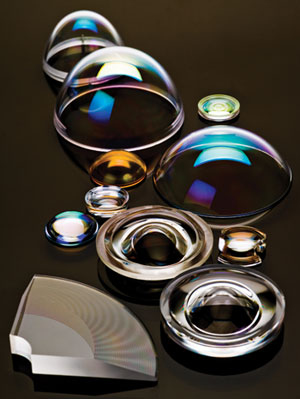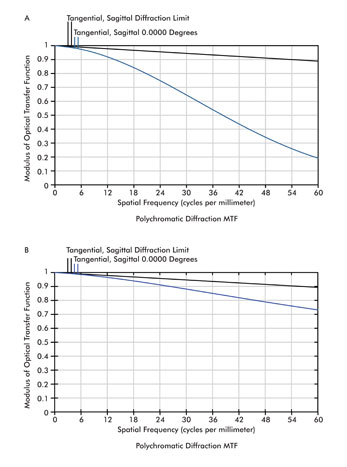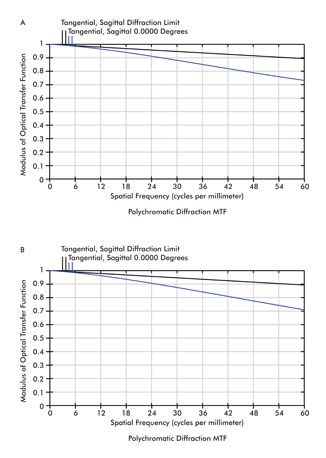Valentina Doushkina, Qioptiq Polymer, Inc.
Polymer materials with optical properties
are being thrust into the design forefront for new, sophisticated electro-optical
applications, enabling commercial markets and applications including medical disposables,
bar-code scan/recognition, security and fingerprint scanners, motion and presence
sensors, CCD cameras and laser collimation. Current advancements in polymer technology
and injection molding capabilities have increased the manufacturability and precision
of polymer optics.
Designing and manufacturing optics and optical systems using polymers
alone or hybrid polymer-glass applications provide complete custom capability and
offer new optical and optomechanical solutions for a variety of applications. Integrated
mounting provides configuration flexibility, design freedom, and simplified optical
alignment, mechanical design, assembly and packaging. A system can be assembled
and aligned in a single manufacturing step.1
Polymer optics: Why and where
In many optical products and applications, traditional optical
glass has been successfully replaced with optical-grade polymers. The main reasons
that polymer optics are chosen for a variety of devices, applications and markets
are the low cost of materials and the fabrication techniques, which offer high production
volume with high precision and fast repeatability.
Among other advantages is high impact resistance: Polymers do
not split like glass, making this type of optics highly useful in terms of durability
and cost efficiency in applications such as head-up displays, goggles, and medical
and biomedical disposable optics. The modern days of nanotechnology are known for
our fascination with compact customer products; e.g., mobile phones, cameras and
microprojectors that can be about the size of a credit card, offering low weight,
affordability, multifunctionality and long-lasting battery charge.
Thanks to their low density or low weight by volume, polymers
are well adapted for making cutting-edge-technology products lighter and smaller.
Polymers are between two and a half and five times lighter than comparable glass
products2 and are suitable for difficult and sophisticated refractive, reflective
and diffractive substrates with spherical, aspherical and cylindrical prescriptions,
thus reducing the number of optical components needed in a given optical system.
Molding is the most repeatable, consistent and economical way to produce complex-shaped
optics in large volume or to integrate them onto a common substrate. Optical-grade
polymers exhibit high light transmittance and are comparable to high-grade crown
glasses. The optical-grade polymer market is growing rapidly; new polymers with
low birefringence as well as higher and more stable refractive indices are available,
offering design flexibility not possible with glass optics on their own.
Grinding and polishing of glass optics is costly and time-consuming,
whereas injection or compression molding of precision polymer optics is inexpensive
and offers design capability and flexibility. Mounting features can be integrated
with optical components, simplifying the assembly and resulting in a compact product
and reduced price. A comparison of the design requirements, manufacturing lead time,
tolerances of finished products and production cost between glass and equivalent
polymers in many applications shows the superiority of polymers.
To utilize polymers, the optical designer must have a solid understanding
of the injection molding process and know how to design optics with polymers. Having
the molding manufacturing company involved in product design at an early stage is
beneficial for cost-effective manufacturing of high-performance optics.
Several diamond-turned and/or injection-molded precision polymer
optical components manufactured at Qioptiq Polymer Inc. are shown in Figure 1.

Figure 1. Qioptiq Polymer Inc. offers a variety of precision polymer optical components. Images courtesy of
Qioptiq Polymer Inc.
Advantages of hybrid optics
In glass-polymer hybrids, a fairly thin layer of aspherized optical
polymer is added to a conventional spherical glass lens. Most optical-grade polymers
have great transmission – comparable to crown glass – so the overall
transmission of the hybrid is comparable to that of glass optics. The advantage
of hybrids is the freedom of glass selection because the glass component is manufactured
conventionally.
Glass-polymer hybrids are widely used in advanced optical systems,
making some applications feasible by reducing component weight, lowering production
cost and enhancing the safety and appeal of products. Applications range from consumer
photographic zoom lenses to professional fast-zoom lenses.
The properties of glass and polymers complement one other; for
example, a nonhydroscopic glass component facing the outer environment protects
the inner aspherized polymer component of a hybrid, while the latter offers a large
numerical aperture, wide-field angles, a diffraction-limited highly resolved image
and a compact design with a minimal number of optical components.
Another advantage is that they have the thermal stability of glass
and the low manufacturing cost of polymer-molded optics. When the glass component
carries the optical power and the thin layer of the aspherized polymer component
corrects for aberrations, the thermal behavior of the hybrids is as stable as that
of glass optics – or even better: Optical glass has a positive dn/dt, while
the optical polymers have a negative dn/dt, enhancing the thermal stability of a
glass-polymer hybrid. The refractive index of optical glass or polymer changes with
the temperature; dn/dt is the temperature coefficient of the refractive index defined
from the curve showing the relationship between glass temperature and refractive
index. The temperature coefficient of refractive index (for light of a given wavelength)
changes with wavelength and temperature.3
An off-the-shelf catalog lens was modeled as an aspherized glass-polymer
hybrid and analyzed for image quality and thermal stability. The sharpness of an
imaging system or of a component of the system is characterized by a parameter called
modulation transfer function (MTF), or spatial frequency response. The polychromatic
diffraction MTF of the glass doublet alone is shown in Figure 2a and is 20 percent
for 60 cycles per millimeter, while the aspherized hybrid shown exhibits 82 percent
MTF for 60 cycles per millimeter (Figure 2B). This is an economical way to create
a high-performance diffraction-limited lens.

Figure 2. The off-the-shelf glass doublet was analyzed via modeling for thermal stability. Image (A) shows the polychromatic diffraction MTF of the glass doublet at 0 °C, and (B) shows the same glass doublet at 70 °C.
The off-the-shelf glass doublet was analyzed via modeling for
thermal stability; the results are shown in Figures 3A and B. The polychromatic
diffraction MTF variation within the temperature range from 0 to 70 °C is about
10 percent.
The modeled aspherized glass-polymer hybrid also was analyzed
for thermal stability. The polychromatic diffraction MTF of the hybrid is shown
in Figures 4A and B. The variation of the MTF within the temperature range from
0 to 70 °C is only 1 percent, compared with that of the glass doublet, which
was 10 percent.
Typical optical polymers
Acrylic (polymethylmethacrylate, or PMMA) is the most commonly
used polymer. It has good clarity and high transmittance in the visible, whereas
polystyrene is a good achromatic pair with acrylic. Polycarbonate is similar to
polystyrene and has high impact strength and good performance over broad temperatures
– up to 120 °C. Polymers have a tendency to absorb water, which can significantly
alter some of their key properties. Those containing only hydrogen and carbon (polyethylene
and polystyrene) are nonhydroscopic (highly water resistant), whereas polymers having
oxygen or oxyhydrogen groups are hydroscopic.

Figure 3. The polychromatic diffraction MTF of the hybrid was
analyzed at 0 °C and (b) at
70 °C.
Zeonex/Zeonor – cyclo olefin polymer – has much lower
water absorption, high transparency and purity, good moldability, low birefringence
(one-third of polycarbonate), high heat resistance – 100 to 160 °C –
and good chemical resistance to acids, bases, alcohols and fragrances.
Ultem PolyEtherImide, an amber transparent high-performance polymer,
combines high strength and rigidity at elevated temperatures with long-term heat
resistance. It excels in reusable medical applications requiring repeated sterilization
and is available in FDA-compliant colors. OKP4 has a high refractive index of 1.6
or more and has extremely low birefringence and high fluidity.2
Innovative hybrid glass-polymer optical solutions on a component
or module level offer the thermal stability of glass with the low manufacturing
cost of polymers as well as enhanced optical performance and a reduced number of
components. The latter characteristics are not achievable when polymer or glass
optics are used on their own.
Meet the author
Valentina Doushkina, MSc, is director of engineering at Qioptiq
Polymer Inc. in La Verne, Calif.; Email: [email protected].
References
1. V. Doushkina and E. Fleming (2009). Optical and mechanical
design advantages using polymer optics, Proc SPIE, Vol. 7424, 74240Q.
2. IDES Prospector. www.ides.com.
3. www.oharacorp.com